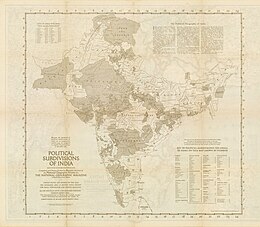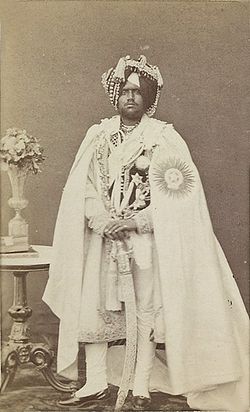Patiala State
| 1763–1947 | |||||||||||||||||||||||
| Capital | Patiala | ||||||||||||||||||||||
| Common languages | Punjabi (official) | ||||||||||||||||||||||
| Religion | Sikh | ||||||||||||||||||||||
| Government | Absolute monarchy (1763 - 1947) | ||||||||||||||||||||||
| Maharaja | |||||||||||||||||||||||
• 1707 - 1765 | Ala Singh Jat | ||||||||||||||||||||||
• 1938 - 1947 | Yadavindra Singh | ||||||||||||||||||||||
| History | |||||||||||||||||||||||
• Established | 1763 | ||||||||||||||||||||||
• Disestablished | 1947 | ||||||||||||||||||||||
| Area | |||||||||||||||||||||||
• Total | 15.389 km2 (5.942 sq mi) | ||||||||||||||||||||||
| Population | |||||||||||||||||||||||
• 1881[1] | 1,467,433 | ||||||||||||||||||||||
• 1891[1] | 1,583,521 | ||||||||||||||||||||||
• 1901[1] | 1,596,692 | ||||||||||||||||||||||
| Currency | Rupee And Paisa | ||||||||||||||||||||||
| |||||||||||||||||||||||
| Today part of | India Pakistan | ||||||||||||||||||||||
Patiala State was a self-governing princely state of the British Empire in India, and one of the Phulkian States, that acceded to the Union of India upon Indian independence and partition.
Etymology[edit | edit source]
The state's name came from the name of its principal city and capital, Patiala, which itself comes from the roots patti and ala. The word patti means "strip of land" in Punjabi, and 'ala' comes from the name of the founder of the city and Patiala state, Ala Singh, thus meaning ‘the land of Ala Singh’ [2]
Brief history[edit | edit source]
| History of India |
|---|

Moti Bagh Palace, Patiala.
In 1763, the Sikh confederation captured the fortress of Sirhind

Maharaja Bhupinder Singh of Patiala
Rulers[edit | edit source]

Maharaja Rajinder Singh of Patiala
The rulers of Patiala bore the title 'Maharaja-e Rajgan' from 1810 onward.[citation needed]
Maharajas[edit | edit source]
- 29 Mar 1761 – 22 August 1765: Ala Singh (b. 1691 – d. 1765)
- 22 Aug 1765 – 1767: Amar Singh (b. 1748 – d. 1781)
Raja-e Rajgan[edit | edit source]
- 1767 – 5 February 1781: Amar Singh (s.a.)
- Feb 1781 – 1810: Sahib Singh (b. 1774 – d. 1813)
Maharaja-e Rajgan[edit | edit source]
- 1810 – 26 March 1813: Sahib Singh (s. a.)
- 26 Mar 1813 – 23 December 1845: Karam Singh (b. 1797 – d. 1845)
- 26 Mar 1813 – 1823: Maharani Aus Kaur (f) – Regent (b. 1772 – d. af.1823)
- 23 Dec 1845 – 13 November 1862: Narendra Singh (b. 1823 – d. 1862) (from 25 June 1861 Sir Narendra Singh)
- 13 Nov 1862 – 14 April 1876: Mahendra Singh (b. 1852 – d. 1876) (from 28 May 1870 Sir Mahendra Singh)
- 13 Nov 1862 – 26 February 1870: Jagdish Singh (Regent, chairman of regency council)
- 14 Apr 1876 – 9 November 1900: Rajinder Singh (b. 1872 – d. 1900) (from 21 May 1898 Sir Rajendra Singh)
- 14 April 1876 – Oct 1890: Sir Deva Singh (Regent) (b. 1834 – d. 1890) (chairman of regency council)
- 9 November 1900 – 23 March 1938: Bhupinder Singh (b. 1891 – d. 1938) (from 12 December 1911 Sir Bhupindra Singh)
- 9 November 1900 – 3 November 1910: Sardar Gurmukh Singh – (Regent, chairman of regency council)
- 23 Mar 1938 – 15 August 1947: Yadavindra Singh (b. 1913 – d. 1974) (from 1 January 1942 Sir Yadavindra Singh)
See also[edit | edit source]
References[edit | edit source]
- ↑ 1.0 1.1 1.2 Imperial gazetteer of India. Vol. XX Pardi to Pusad. 1908. pp. 40, 42.
- ↑ ""THE DEVELOPMENT OF EDUCATION IN PATIALA DISTRICT (1948-2001): A GENDERED ANALYSIS"".
{{cite journal}}: Cite journal requires|journal=(help)
Further reading[edit | edit source]
- Chavan, Akshay (15 February 2019), "Hitler's Gift to The Maharaja of Patiala", Live History India
- Dhavan, Purnima (2011). When Sparrows Became Hawks: The Making of the Sikh Warrior Tradition, 1699-1799. Oxford University Press (US). ISBN 978-0199756551.
- Priscoli, Jerome Delli; Wolf, Aaron T. (2010). Managing and Transforming Water Conflicts. Cambridge University Press. ISBN 978-0521632164.





